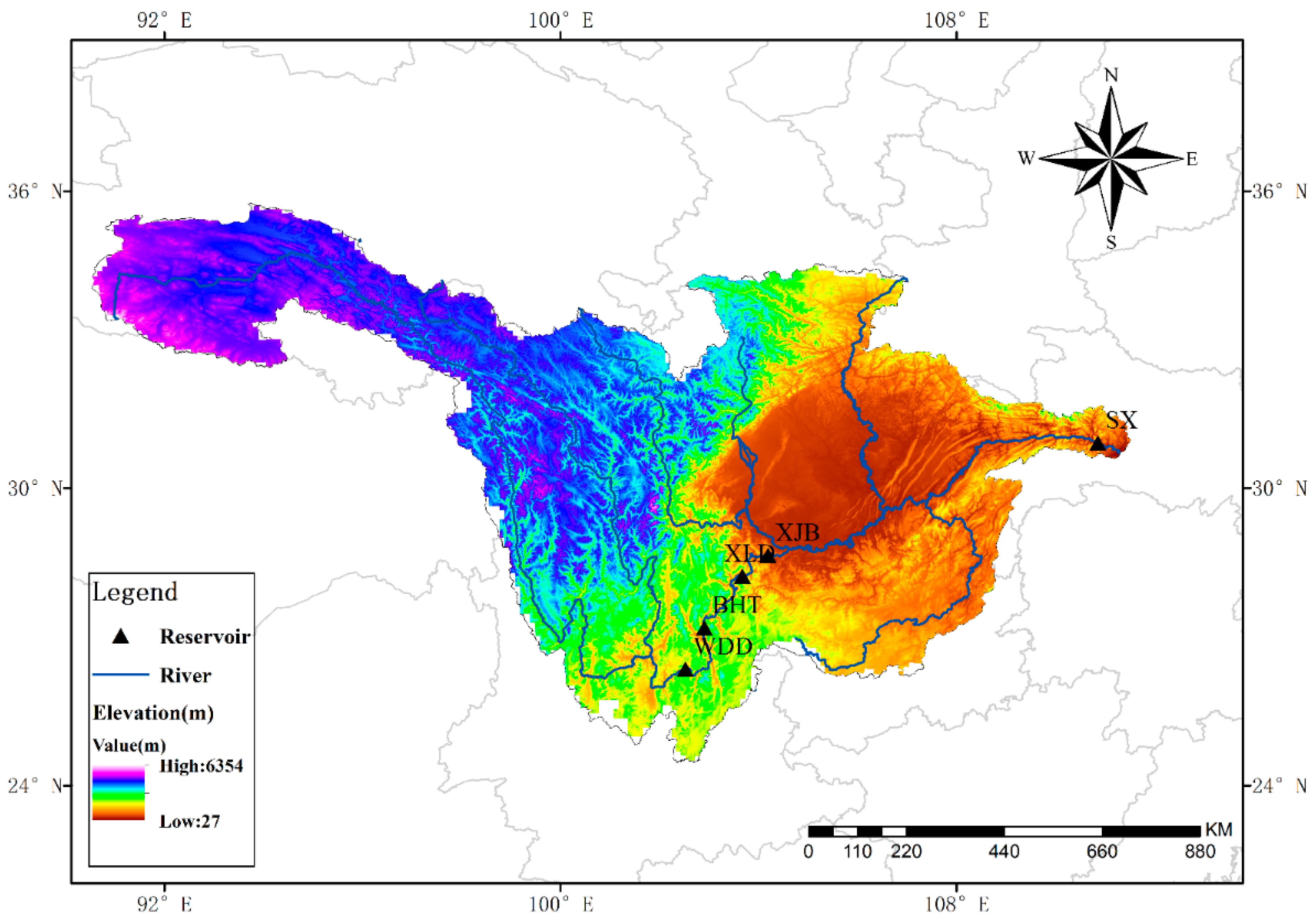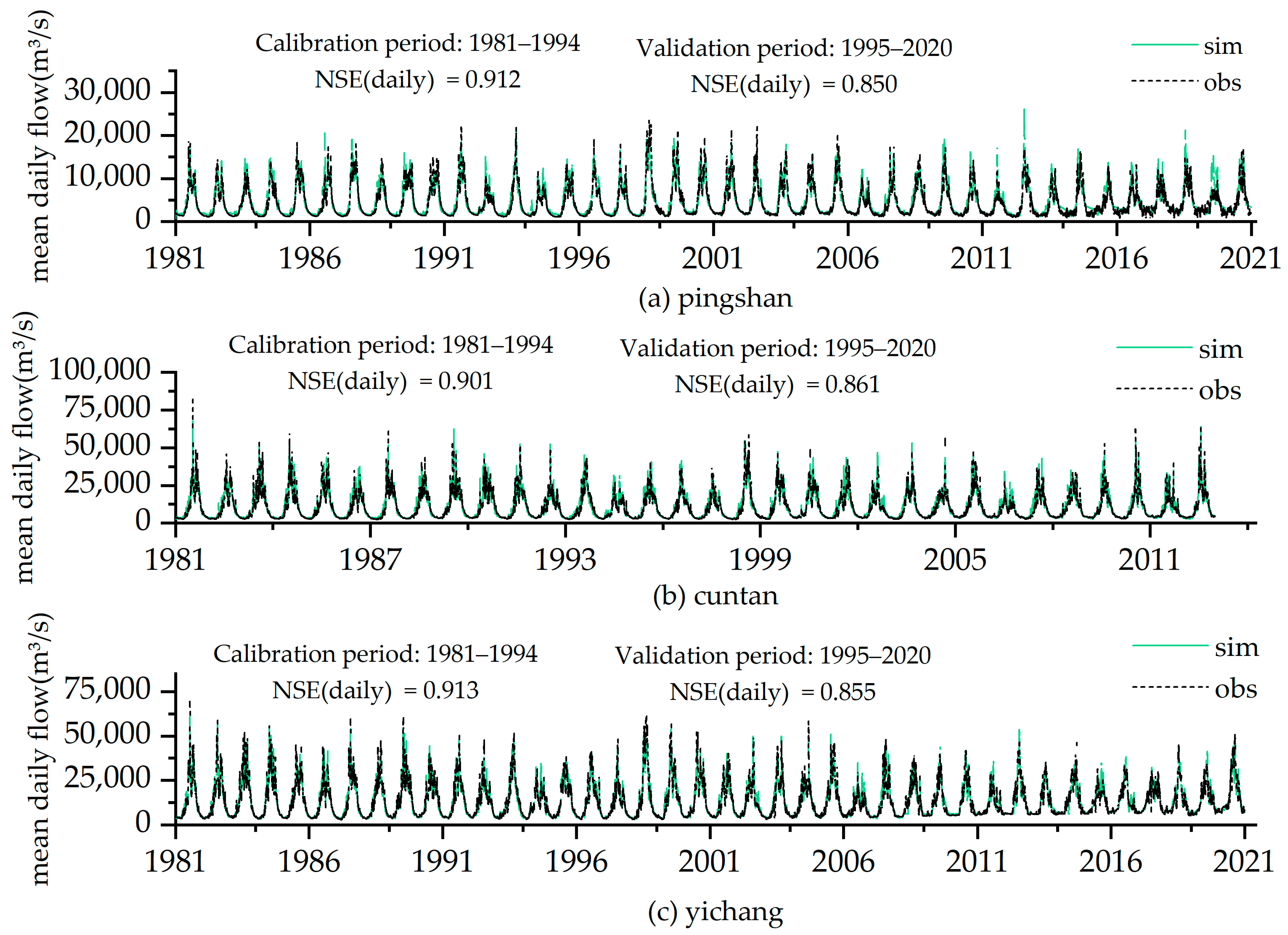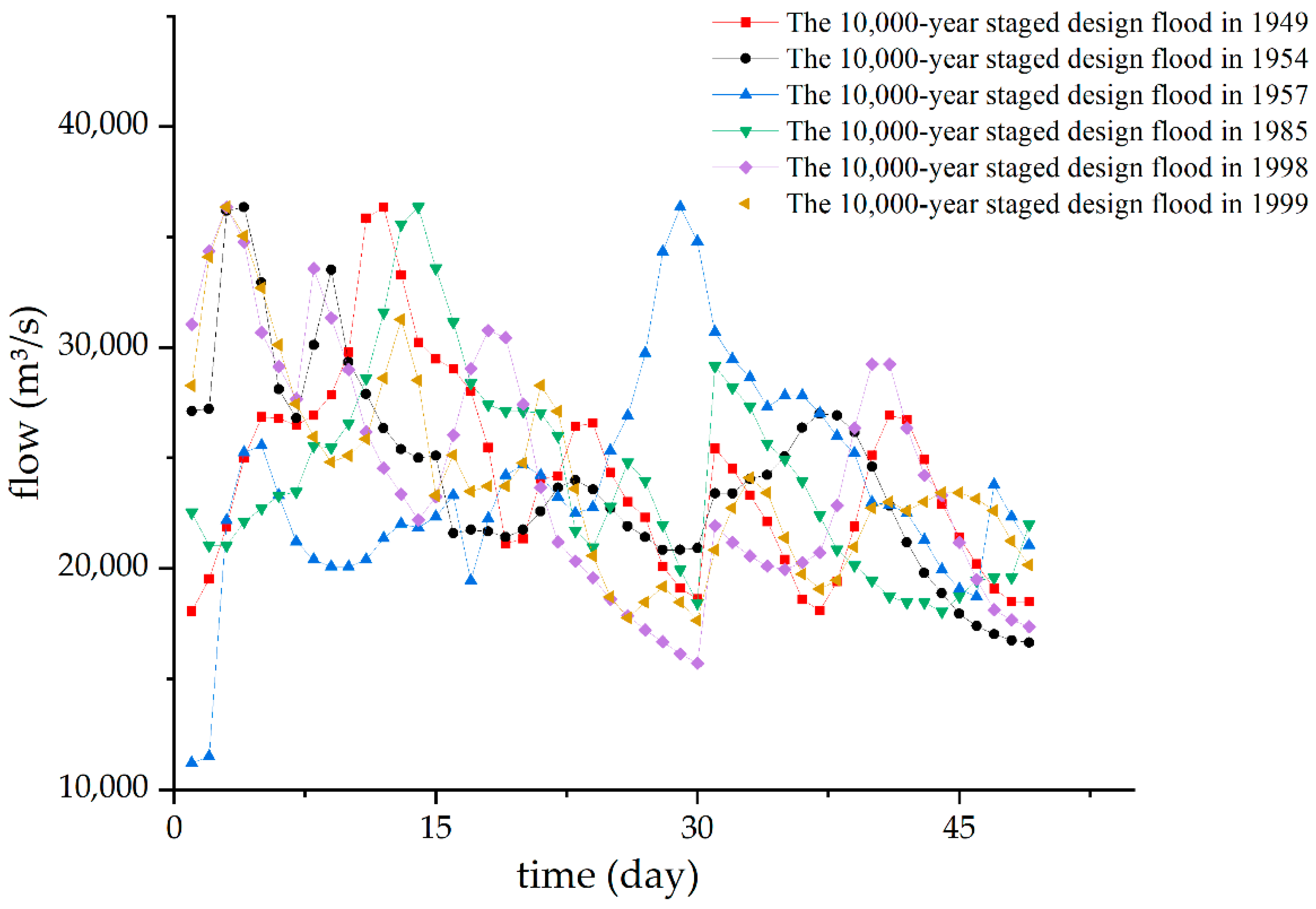The Optimization of Water Storage Timing in Upper Yangtze Reservoirs Affected by Water Transfer Projects
Abstract
:1. Introduction
2. Materials and Methods
2.1. Study Area
2.2. Water Storage Periods
2.3. CLHMS Model
3. Model Validation and Optimization Scheme Design
3.1. Model Calibration and Validation
3.2. Optimization of Water Storage Timing Strategies
3.2.1. Reservoir Inflow Classification
3.2.2. Reservoir Fullness Rate
3.2.3. Optimization Methods for Reservoir Water Storage Timing
- The flow data from the Wudongde Dam site and the interval flow of cascading reservoirs from 1981 to 2020 are utilized as input, considering the regulation effect between cascading reservoirs. By simulating the scheduling according to each reservoir’s scheduling procedure, the reservoir’s annual simulated storage process is calculated. The number of years (n1) when the reservoir is full at the end of the year is recorded, and the pre-diversion full storage rate was calculated as Rf1 = n1/N, where Rf1 represents the pre-diversion reservoir storage rate; N is the total number of years of reservoir storage, which is 40 years in total; and n1 represents the number of years with full reservoir storage.
- Post-diversion flow data from the Wudongde Dam site and cascading reservoirs from 1981 to 2020 are utilized as input, considering the regulation effect between cascading reservoirs. By advancing the storage time by j days and simulating the scheduling, the reservoir’s annual simulated storage process is calculated, and the number of years (n2) when the reservoir is full at the end of the year is recorded. The corresponding full storage rate under the diversion scenario is Rfj2 = n2/N, where Rfj2 represents the reservoir storage rate after diversion with j days of advanced filling; N signifies the total number of years for reservoir storage, which spans 40 years in total; and n2 denotes the number of years without full reservoir storage.
- The pre-diversion full storage rate Rf1 is compared with the corresponding full storage rate Rfj2 when storage is advanced by j days post-diversion. When Rf1 is less than or equal to Rfj2, the number of days to advance storage under the influence of the diversion project is P = j, where Rf1 represents the reservoir storage rate before diversion, Rfj2 denotes the reservoir storage rate in the diversion scenario with j days of advanced filling, and P represents the number of days by which the reservoir should be filled in advance to ensure that the post-diversion storage rate is not lower than the pre-diversion storage rate.
- If Rf1 is greater than or equal to Rfj2, j is increased by 1, and steps b-c are repeated. The maximum number of days that each reservoir (Wudongde, Baihetan, Xiluodu, Xiangjiaba, and Three Gorges) can advance storage, denoted as P1, P2, P3, P4, and P5, and the corresponding end-of-flood-season advance storage plans are then calculated, where Rf1 represents the reservoir storage rate before diversion; Rfj2 represents the reservoir storage rate in the diversion scenario with j days of advanced filling; and P1, P2, P3, P4, and P5 indicate the number of days each reservoir should fill in advance.
3.2.4. Methodology for Reservoir Flood Risk Analysis
4. Results
4.1. Impact of Water Transfer on Reservoir Filling Rates
4.2. Optimization of Reservoir Water Storage Timing
4.3. Optimization of Reservoir Water Storage Timing
4.4. Impact of Reservoir Water Storage Timing Optimization on Power Generation
5. Discussion
6. Conclusions
- (1)
- The implementation of inter-basin water transfer projects in the Yangtze River Basin has negatively impacted the storage efficiency of the mainstream cascade reservoirs. Specifically, the Baihetan and Three Gorges reservoirs experienced a significant decline in their storage levels, decreasing by 7.5% and 2.5%, respectively, after the water transfer.
- (2)
- By advancing the water storage schedule by five days for both the Baihetan and Three Gorges reservoirs, their storage levels were restored to pre-transfer conditions while still meeting flood control requirements. This indicates that early water storage effectively mitigates the adverse effects of water transfer on reservoir storage efficiency.
- (3)
- Implementing the proposed early storage plan—namely advancing water storage by five days for both the Baihetan and Three Gorges reservoirs—achieved dual benefits: It restored the reservoirs’ storage levels and enhanced their electricity generation. In non-transfer scenarios, the Baihetan and Three Gorges reservoirs experienced an increase in electricity generation by 1.357 and 3.183 billion kWh, respectively. In transfer scenarios, the increases were 1.48 and 2.759 billion kWh, respectively. This demonstrates that optimizing the timing of water storage not only restores the reservoirs’ storage levels but also enhances their electricity generation capabilities.
Author Contributions
Funding
Data Availability Statement
Conflicts of Interest
References
- Gleick, P.H. Water in Crisis; Oxford University Press: Oxford, UK, 1993; 473p. [Google Scholar]
- Wada, Y.; Bierkens, M.F.P. Sustainability of global water use: Past reconstruction and future projections. Environ. Res. Lett. 2014, 9, 104003. [Google Scholar] [CrossRef]
- Hoekstra, A.Y.; Mekonnen, M.M. The water footprint of humanity. Proc. Natl. Acad. Sci. USA 2012, 109, 3232–3237. [Google Scholar] [CrossRef] [PubMed]
- Ma, T.; Sun, S.; Fu, G.; Hall, J.W.; Ni, Y.; He, L.; Yi, J.; Zhao, N.; Du, Y.; Pei, T. Pollution exacerbates China’s water scarcity and its regional inequality. Nat. Commun. 2020, 11, 650. [Google Scholar] [CrossRef] [PubMed]
- Zheng, S.; Zhong, Z.; Zou, Q.; Ding, Y.; Yang, L.; Luo, X. Overall Situation of Yangtze River Basin. In Flood Resources Utilization in the Yangtze River Basin; Springer: Singapore, 2021; pp. 19–69. [Google Scholar]
- Guan, D.; Hubacek, K. Assessment of regional trade and virtual water flows in China. Ecol. Econ. 2007, 61, 159–170. [Google Scholar] [CrossRef]
- Zhang, Y.; Khan, S.U.; Swallow, B.; Liu, W.; Zhao, M. Coupling coordination analysis of China’s water resources utilization efficiency and economic development level. J. Clean. Prod. 2022, 373, 133874. [Google Scholar] [CrossRef]
- Sun, S.; Zhou, X.; Liu, H.; Jiang, Y.; Zhou, H.; Zhang, C.; Fu, G. Unraveling the effect of inter-basin water transfer on reducing water scarcity and its inequality in China. Water Res. 2021, 194, 116931. [Google Scholar] [CrossRef] [PubMed]
- Zhuang, W. Eco-environmental impact of inter-basin water transfer projects: A review. Environ. Sci. Pollut. Res. 2016, 23, 12867–12879. [Google Scholar] [CrossRef]
- Yu, M.; Wang, C.; Liu, Y.; Olsson, G.; Wang, C. Sustainability of mega water diversion projects: Experience and lessons from China. Sci. Total Environ. 2018, 619–620, 721–731. [Google Scholar] [CrossRef]
- Li, Y.; Nzudie, H.L.F.; Zhao, X.; Wang, H. Addressing the Uneven Distribution of Water Quantity and Quality Endowment: Physical and Virtual Water Transfer within China; Springer: Berlin/Heidelberg, Germany, 2019. [Google Scholar]
- Wang, W.; Zhu, Y.; Dong, S.; Becker, S.; Chen, Y. Attribution of decreasing annual and autumn inflows to the Three Gorges Reservoir, Yangtze River: Climate variability, water consumption or upstream reservoir operation? J. Hydrol. 2019, 579, 124180. [Google Scholar] [CrossRef]
- Zhou, J.; Zhang, Y.; Zhang, R.; Ouyang, S.; Wang, X.; Liao, X. Integrated optimization of hydroelectric energy in the upper and middle Yangtze River. Renew. Sustain. Energy Rev. 2015, 45, 481–512. [Google Scholar] [CrossRef]
- Yang, Z.; Cai, Y.; Mitsch, W.J. Ecological and hydrological responses to changing environmental conditions in China’s river basins. Ecol. Eng. 2015, 76, 1–6. [Google Scholar] [CrossRef]
- He, S.; Guo, S.; Yin, J.; Liao, Z.; Li, H.; Liu, Z. A novel impoundment framework for a mega reservoir system in the upper Yangtze River basin. Appl. Energy 2022, 305, 117792. [Google Scholar] [CrossRef]
- Ahmad, A.; El-Shafie, A.; Razali, S.F.M.; Mohamad, Z.S. Reservoir Optimization in Water Resources: A Review. Water Resour. Manag. 2014, 28, 3391–3405. [Google Scholar] [CrossRef]
- Kuriqi, A.; Pinheiro, A.N.; Sordo-Ward, A.; Bejarano, M.D.; Garrote, L. Ecological impacts of run-of-river hydropower plants—Current status and future prospects on the brink of energy transition. Renew. Sustain. Energy Rev. 2021, 142, 110833. [Google Scholar] [CrossRef]
- Dong, N.; Yang, M.; Yu, Z.; Wei, J.; Yang, C.; Yang, Q.; Liu, X.; Lei, X.; Wang, H.; Kunstmann, H. Water resources management in a reservoir-regulated basin: Implications of reservoir network layout on streamflow and hydrologic alteration. J. Hydrol. 2020, 586, 124903. [Google Scholar] [CrossRef]
- Yu, Y.; Zhao, R.; Zhang, J.; Yang, D.; Zhou, T. Multi-objective game theory optimization for balancing economic, social and ecological benefits in the Three Gorges Reservoir operation. Environ. Res. Lett. 2021, 16, 085007. [Google Scholar] [CrossRef]
- Jing, Z.; An, W.; Zhang, S.; Xia, Z. Flood control ability of river-type reservoirs using stochastic flood simulation and dynamic capacity flood regulation. J. Clean. Prod. 2020, 257, 120809. [Google Scholar] [CrossRef]
- Dittmann, R.; Froehlich, F.; Pohl, R.; Ostrowski, M. Optimum multi-objective reservoir operation with emphasis on flood control and ecology. Nat. Hazards Earth Syst. Sci. 2009, 9, 1973–1980. [Google Scholar] [CrossRef]
- Li, Y.; Gan, F.; Deng, J. Preliminary study on impounding water of Three Gorges Project in September. J. Hydraul. Eng. 2008, 27, 110–114. [Google Scholar]
- Liu, X.-y.; Guo, S.-l.; Liu, P.; Li, X. Scheme of impounding in advance for the Three Gorges Reservoir by considering the comprehensive utilization benefits. Adv. Water Sci. 2009, 20, 851–856. [Google Scholar]
- Guo, J.; Guo, S.; Li, T.; Chen, G. Flood control risk analysis model of impounding water in advance for Three Gorges reservoir Shuili Fadian Xuebao. J. Hydroelectr. Eng. 2012, 31, 16–21. [Google Scholar]
- Ouyang, S.; Zhou, J.; Zhang, R.; Wang, X.M.; Wang, H. Study on optimal scheduling of multi-objective joint flood control for lower Jinsha River cascade reservoirs and Three Gorges reservoir. J. Hydroelectr. Eng. 2013, 32, 43–49. [Google Scholar]
- Peng, Y.; Li, Y.T.; Zhang, H.W. Multi-objective decision-making model for coordinative dispatch of water and sediment in reservoir. J. Hydraul. Eng. 2004, 4, 1–7. [Google Scholar]
- Peng, Y.; Ji, C.; Liu, F. Impounding time and objective decision of Xiluodu-Xiangjiaba cascade reservoirs in the flood recession period. J. Basic Sci. Eng. 2014, 22, 1098–1107. [Google Scholar]
- Li, Q.; Bai, X.; Lu, G.; Zou, Z.; Cai, T. Impact of the Three Gorges reservoir operation with different schemes on the downstream ecological water use Shuili Fadian Xuebao. J. Hydroelectr. Eng. 2011, 30, 124–128. [Google Scholar]
- Dong, N.; Guan, W.; Cao, J.; Zou, Y.; Yang, M.; Wei, J.; Chen, L.; Wang, H. A hybrid hydrologic modelling framework with data-driven and conceptual reservoir operation schemes for reservoir impact assessment and predictions. J. Hydrol. 2023, 619, 129246. [Google Scholar] [CrossRef]
- Galletti, A.; Avesani, D.; Bellin, A.; Majone, B. Detailed simulation of storage hydropower systems in large Alpine watersheds. J. Hydrol. 2021, 603, 127125. [Google Scholar] [CrossRef]






| Project Name | Water Resources | Water Receiving Area | Designed Annual Water Transfer Demand (Billion m3) |
|---|---|---|---|
| P1 | Upstream of the Three Gorges Dam | Hubei Province | 3.9 |
| P2 | Jinsha River | Honghezhou | 3.403 |
| P3 | Daikosi Reservoir | Gansu Province | 0.96 |
| P4 | Shuangjiangkou | Yellow River Basin | 8 |
| P5 | Lianghekou and Yebatan | Yellow River Basin | 9 |
| Wet Years | Normal Years | Dry Years | |||
|---|---|---|---|---|---|
| Year | The Average Flow during the Storage Period (m3/s) | Year | The Average Flow during the Storage Period (m3/s) | Year | The Average Flow during the Storage Period (m3/s) |
| 1998 | 14,857 | 2014 | 7744 | 1995 | 5520 |
| 1991 | 10,854 | 2001 | 7525 | 2016 | 5395 |
| 2005 | 10,797 | 1996 | 7129 | 2013 | 5344 |
| 2009 | 10,747 | 2017 | 6726 | 1988 | 5102 |
| 2020 | 10,408 | 2004 | 6592 | 2019 | 4832 |
| 1993 | 10,286 | 1989 | 6470 | 2011 | 4730 |
| 2002 | 10,228 | 1985 | 6056 | 1983 | 4561 |
| 2018 | 8967 | 2010 | 6027 | 1982 | 4334 |
| 1999 | 8846 | 2003 | 5972 | 1992 | 4280 |
| 1987 | 8707 | 2007 | 5942 | 1986 | 4207 |
| 2008 | 8624 | 1981 | 5843 | 1994 | 3795 |
| 2000 | 8475 | 1997 | 5674 | 2015 | 3609 |
| 2012 | 8156 | 1984 | 5672 | 2006 | 3452 |
| 1990 | 5653 | ||||
| Reservoir | Storage Period | The Full Storage Conditions of the Reservoir |
|---|---|---|
| WDD | 8.1–8.30 | The water level on 30 August: =975 m |
| BHT | 8.1–9.10 | The water level on 10 September: =825 m |
| XLD | 9.10–9.30 | The water level on 30 September: =600 m |
| XJB | 9.10–9.30 | The water level on 30 September: =380 m |
| SX | 9.10–10.31 | The water level on 31 October: =175 m |
| Reservoir | Full Storage Rate of Reservoir before Water Transfer (%) | Full Storage Rate of the Reservoir After Water Transfer (%) | ||||||
|---|---|---|---|---|---|---|---|---|
| Wet Years | Normal Years | Dry Years | Total | Wet Years | Normal Years | Dry Years | Total | |
| WDD | 100 | 100 | 100 | 100 | 100 | 100 | 100 | 100 |
| BHT | 100 | 100 | 84 | 95 | 100 | 100 | 62 | 87.5 |
| XLD | 100 | 100 | 100 | 100 | 100 | 100 | 100 | 100 |
| XJB | 100 | 100 | 100 | 100 | 100 | 100 | 100 | 100 |
| SX | 100 | 100 | 70 | 90 | 100 | 100 | 62 | 87.5 |
| Reservoir | Time to Start Reservoir Storage | Days to Start Storing Water Early (d) | Reservoir Fullness Rates (%) | |||
|---|---|---|---|---|---|---|
| Wet Years | Normal Years | Dry Years | Total | |||
| WDD | 1 August | 0 | 100 | 100 | 100 | 100 |
| BHT | 27 July | 5 | 100 | 100 | 93 | 100 |
| XLD | 10 September | 0 | 100 | 100 | 100 | 100 |
| XJB | 10 September | 0 | 100 | 100 | 100 | 100 |
| SX | 6 September | 5 | 100 | 100 | 93 | 97.3 |
| Reservoir | Before Optimization | After Optimization | Increased Power Generation | Increase Percentage (%) | ||||
|---|---|---|---|---|---|---|---|---|
| No Water Transfer | Water Transfer | No Water Transfer | Water Transfer | No Water Transfer | Water Transfer | No Water Transfer | Water Transfer | |
| WDD | 54.58 | 51.35 | 54.58 | 51.35 | 0 | 0 | 0.00% | 0.00% |
| BHT | 87.11 | 79.26 | 100.68 | 94.06 | 13.57 | 14.8 | 15.58% | 18.67% |
| XLD | 53.97 | 48.64 | 53.97 | 48.64 | 0 | 0 | 0.00% | 0.00% |
| XJB | 25.85 | 23.22 | 25.85 | 23.22 | 0 | 0 | 0.00% | 0.00% |
| SX | 135.21 | 128.85 | 167.04 | 156.44 | 31.83 | 27.59 | 23.54% | 21.41% |
| Total | 356.72 | 331.32 | 402.12 | 373.71 | 45.4 | 42.39 | 12.73% | 12.79% |
Disclaimer/Publisher’s Note: The statements, opinions and data contained in all publications are solely those of the individual author(s) and contributor(s) and not of MDPI and/or the editor(s). MDPI and/or the editor(s) disclaim responsibility for any injury to people or property resulting from any ideas, methods, instructions or products referred to in the content. |
© 2023 by the authors. Licensee MDPI, Basel, Switzerland. This article is an open access article distributed under the terms and conditions of the Creative Commons Attribution (CC BY) license (https://creativecommons.org/licenses/by/4.0/).
Share and Cite
Wen, F.; Guan, W.; Yang, M.; Cao, J.; Zou, Y.; Liu, X.; Wang, H.; Dong, N. The Optimization of Water Storage Timing in Upper Yangtze Reservoirs Affected by Water Transfer Projects. Water 2023, 15, 3393. https://doi.org/10.3390/w15193393
Wen F, Guan W, Yang M, Cao J, Zou Y, Liu X, Wang H, Dong N. The Optimization of Water Storage Timing in Upper Yangtze Reservoirs Affected by Water Transfer Projects. Water. 2023; 15(19):3393. https://doi.org/10.3390/w15193393
Chicago/Turabian StyleWen, Fan, Wenhai Guan, Mingxiang Yang, Jixue Cao, Yibo Zou, Xuan Liu, Hejia Wang, and Ningpeng Dong. 2023. "The Optimization of Water Storage Timing in Upper Yangtze Reservoirs Affected by Water Transfer Projects" Water 15, no. 19: 3393. https://doi.org/10.3390/w15193393
APA StyleWen, F., Guan, W., Yang, M., Cao, J., Zou, Y., Liu, X., Wang, H., & Dong, N. (2023). The Optimization of Water Storage Timing in Upper Yangtze Reservoirs Affected by Water Transfer Projects. Water, 15(19), 3393. https://doi.org/10.3390/w15193393













